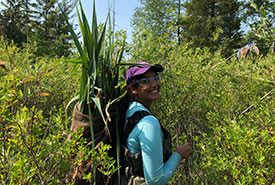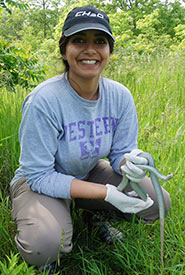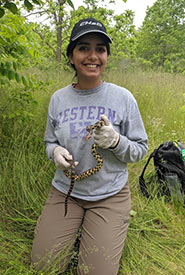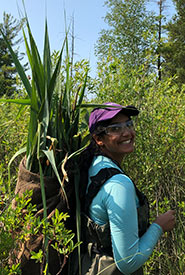Life in Ontario's deep south

Hauling out invasive phragmites that were removed on an NCC property. (Photo by NCC)
The ferry landed, and I peered through the window to see an impressive island among the lapsing water of Lake Erie. This was the beginning of my first visit to Pelee Island as a conservation technician interning for the Nature Conservancy of Canada (NCC) this past summer.
Growing up in Essex County, I visited Pelee Island many times as a child. But looking at it through a conservation-focused lens has allowed me to truly appreciate its natural spaces and NCC’s work to maintain prime habitat on the unique freshwater island.
Related content
Pelee Island is the most southerly inhabited island in Canada (Middle Island is officially the most southern island but remains uninhabited and maintained as a natural area by Parks Canada). It is home to many unique species and diverse ecosystems, many of which can be seen on NCC’s various properties on the island.
NCC owns approximately 428 hectares (1,058 acres) of land on Pelee Island, approximately 10 per cent of the island. Other protected land makes up about 375 hectares (926 acres). NCC’s properties, in combination with other protected land, total 18 per cent of the Island.
Unique species
Pelee Island is home to beautiful flora and fauna. The plant and animal communities of many of the natural areas differs greatly from the mainland. I appreciated how lush the woodlands and meadows are on Pelee Island, such as at the Richard and Beryl Ivey property, which features trails to enjoy these scenic views.

Noor holding a blue racer while assisting with a research project that assesses rare snake populations on conservation lands. (Photo by NCC)
There are also species endemic to Pelee Island and found nowhere else in Canada, such as blue racer and small-mouth salamander. In early spring, many migratory birds stop on Pelee Island prior to migrate to their nesting sites, making much of the island ideal for birdwatching. If you’re feeling ambitious, you can even get a team together and participate in The Annual Springsong – A Celebration of Birds and Birding.
Diverse landscapes
Working on Pelee Island has made me appreciate its natural spaces even more. From the alvar communities on NCC’s Stone Road Alvar, to the created wetland complexes in the Florian Diamante Nature Reserve, Pelee Island has such diverse habitat. This also means that it requires a lot of monitoring and management. I helped with tasks like invasive species removal, mapping plant communities, monitoring and maintenance.

Noor with an eastern foxsnake awaiting to take the snake's measurements. (Photo by NCC)
NCC’s properties here feature a variety of landscapes. One of my favourites is Middle Point Woods, which has two kilometres of protected shoreline. I recall seeing a Lake Erie watersnake swimming through the water to eat its prey along the shoreline. There are also many birds that regularly fly in from the lake and make pit stops in Middle Point Woods, a haven right along the heavily developed shoreline. Each NCC property on Pelee Island offers something unique.
Pelee Island is home to many amazing species, as well as several incredible volunteers and partners who help us maintain, monitor and restore more habitat for the many species that live on the island. Pelee Island’s biodiversity is something for all to enjoy.


